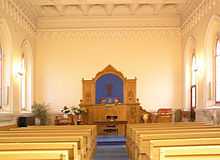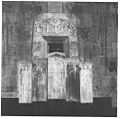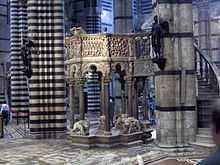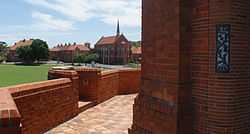Pulpit


Pulpit is a speakers' stand in a church. In many Christian churches, there are two speakers' stands at the front of the church. often, the one on the left (as viewed by the congregation) is called the pulpit. Since the Gospel lesson is often read from the pulpit, the pulpit side of the church is sometimes called the gospel side.
The other speaker's stand, usually on the right (as viewed by the congregation), is known as the lectern. The word lectern comes from the Latin word "lectus", past participle of legere, meaning "to read", because the lectern primarily functions as a reading stand. It is typically used by lay people to read the scripture lessons (except for the Gospel lesson), to lead the congregation in prayer, and to make announcements. Because the epistle lesson is usually read from the lectern, the lectern side of the church is sometimes called the epistle side. In other churches, the lectern, from which the Epistle is read, is located to the congregation's left and the pulpit, from which the sermon is delivered, is located on the right (the Gospel being read from either the center of the chancel or in front of the altar).
Protestantism
In some Protestant churches, the pulpit is considered the most important piece of furniture in the sanctuary. It is located centrally in relation to the congregation and raised. It is where the minister stands and may be decorated with a 'pulpit fall'- a piece of cloth that covers the top of the pulpit and hangs down the front. Flowers may also stand in front of the pulpit.
In the eighteenth century, triple-decker pulpits were often introduced in English-speaking countries. The three levels of lecterns were intended to show the relative importance of the readings delivered there. The bottom tier was for community announcements, the middle was for the gospel, and the top tier was reserved for the delivery of the sermon. A good example of a three-decker pulpit is found in the parish church of St Andrew, Slaidburn, Lancashire.
In many Evangelical Christian churches, the pulpit stands squarely in the center of the platform, and is generally the largest piece of church furniture. This is to symbolize the proclamation of the Word of God as the central focus of the weekly service of worship. In more contemporary evangelical churches, the pulpit may be much smaller, if used at all, and is generally carried out after the end of the song service. However, it usually is placed in the center of the platform as well.
From the pulpit is often used metaphorically for something which is said with official church authority.
Presbyterian churches

Traditional Presbyterian Churches in Scotland and elsewhere often had a Central pulpit, that is, the Pulpit was located in the centre of the chancel in the position where most churches have the communion table or altar. The table could be situated in front of the pulpit or to the side, and sometimes was not in the chancel area at all.
This declares the Bible to be the foundation of the faith, something which is true in all Christian traditions, but is particularly highlighted by some more than others. Furthermore, the "Centrality of the Word" implies that the reading and preaching of the Bible is the centrepiece of a service of worship, and thus takes priority over the sacraments. The Central Pulpit is intended to give visual representation of this idea.[1][2]
Since the late 19th century, the fashion in the Church of Scotland and most other Presbyterian denominations has been for a return to the pre-reformation layout. Thus many buildings which once had a central pulpit now have a pulpit to the side. See for example Skene Parish Church or Old West Church, Boston, Massachusetts.
This Presbyterian tradition is historically distinct from the tradition of the ambon in Eastern Christianity.
Roman Catholicism
In Roman Catholic churches, the stand used for readings and homilies is called the ambo. Despite its name, this structure more closely resembles a lectern than the ambon of the Eastern Rites. The General Instruction of the Roman Missal (GIRM) specifies:
309. The dignity of the Word of God requires that in the church there be a suitable place from which it may be proclaimed and toward which the attention of the faithful naturally turns during the Liturgy of the Word. It is appropriate that generally this place be a stationary ambo and not simply a movable lectern. The ambo must be located in keeping with the design of each church in such a way that the ordained ministers and readers may be clearly seen and heard by the faithful. From the ambo only the readings, the Responsorial Psalm, and the Easter Proclamation (Exsultet) are to be proclaimed; likewise it may be used for giving the Homily and for announcing the intentions of the Universal Prayer. The dignity of the ambo requires that only a minister of the word should stand at it. ...[3]
Ambon
In churches where there is only one speaker's stand in the center of the front of the church, it serves the functions of both lectern and pulpit and is properly called the ambon or ambo. In common usage, however, ambos are incorrectly called pulpits.
The word ambo comes from a Greek word meaning an elevation. It was originally an elaborate raised platform in the middle of the nave from which the Epistle and Gospel would be read, and was occasionally used as a speaker's platform for homilies. It was joined to the sanctuary by a raised walkway called the soleas. In modern Eastern Christian use, this form of the ambo is now very rare. Instead, the area directly in front of the Beautiful Gates of the iconostasis from which the Gospel is typically read is called the ambo, and the entire low elevation above the level of the nave in front of the iconostasis is called the soleas. In larger churches, the ambo might be distinguished by three curved steps from which one might reach it from the nave.[4]
In Eastern Orthodox cathedrals there is usually a low platform in the center of the nave called the episcopal ambo where the bishop is vested prior to the Divine Liturgy and where he is enthroned until the Little Entrance. If the bishop is serving in a simple parish church, an episcopal ambo is set temporarily in place.
In addition to the ambo, many major churches in Greece and Cyprus also have a raised pulpit on the left side of the nave, usually attached to a column and raised several feet high. This is reached by a narrow flight of stairs. It is considered an architectural element that is symmetrical to the bishop's throne, which is located on an equivalent position on the right. Pulpit and throne are usually similar in construction, usually made of either sculpted stone or sculpted wood. This pulpit was used mostly for sermons and in order to improve audibility, before the advent of modern public address systems in churches. Nowadays it is used rarely. Tradition dictates that it be used for the reading of the "12 Passion Gospels" during the Matins of Holy Friday, served late in the evening of Maundy Thursday. This is done to signify that the Passion of Christ is being "broadcast" for all to know. In the same spirit, a phonetic transcription of the relevant Gospel passages is provided in several common languages (e.g. English, French, Russian, Arabic etc.), so that they may be read from this pulpit at the same time.
Gallery
Outdoor pulpits
-
Open-air pulpit in the forecourt of the Chapel at Scotch College, Melbourne
-

Fr. Coughlin's outdoor pulpit at the Shrine of the Little Flower in Royal Oak, Michigan.
Modern pulpits
-

A modern pulpit on the chancel of a Presbyterian Church in California
-

A modern pulpit in Jakobskirken, Roskilde, Denmark.
Older-style pulpits
-

Carved stone pulpit by Nicola Pisano inside Siena Cathedral, Italy
-

Late Baroque polychromed pulpit accessed from the balcony in the pilgrimage church of Ss. Philippus and Jakobus, Bergatreute.
-

Pulpit from Henry II (1014) in the Aachen Cathedral, Germany
-

Pulpit at Enånger old church in Sweden
-
Terracotta Pulpit at Pieve delle Sante Flora e Lucilla in Santa Fiora, Italy
-
Stone pulpit at Chiesa Bartolomeo in Pantano Pistoia Italy
-
Pulpit at St. John the Baptist Cathedral, Yaroslavl, Russia (17th century)
-
Stone pulpit at Worcester cathedral England
-

Wooden pulpit at the Church of the Holy Ghost in Tallinn in Estonia
-
Wooden pulpit in Wakken, Dentergem, Belgium
-
A Calvinist 17th century pulpit of the Calvinist Dutch Reformed church in Buren, the Netherlands.
-

Pulpit of the Gallus chapel in Greifensee ZH, Switzerland
-
Wooden neo-roman pulpit at the Saint Remigius Church, Simpelveld, Netherlands
-
External gothic pulpit in Saint-Lô, France
-

Baroque pulpit in the Amiens Cathedral, France
-

Pulpit in the Saint-Thiébaut Church, Thann, France
-

Pulpit of Strasbourg Cathedral, France
-

Pulpit of Old Ship Church, Hingham, Massachusetts
-

Stone pulpit with wooden top in the Collégiale Saint-Florent, Niederhaslach, France
-

Gothic-revival "wine glass" pulpit and sounding board from 1872 in St. Matthew's German Evangelical Lutheran Church, Charleston, South Carolina
| Wikimedia Commons has media related to Pulpits. |
See also
References
- ↑ "Where's the Pulpit go?". Retrieved 2010-03-10.
- ↑ Ronald L. Dart. "The performance church". Retrieved 2010-03-10.
- ↑ "Chapter V: The Arrangement and Ornamentation of Churches for the Celebration of the Eucharist". General Instruction of the Roman Missal (United States Conference of Catholic Bishops). 2011.
- ↑ Catholic Encyclopædia: Ambo (in the Russian and Greek Church)
http://www.bluegumjoinery.com.au/Custom_lecterns.html church pulpit


.jpg)









